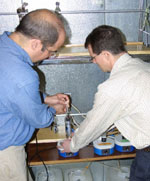Advanced in-vitro process developed at MUSC
An advanced in-vitro lab technique, proven to be valuable in the study of antibiotic medications, has caught the attention of Abbott Laboratories, whose research scientist was here for three days last week to learn from the MUSC investigators who developed it. Abbott
Laboratories' Drs. John Meulbroek, left, and Kevin Enzweiler draw a sample
for bacterial count and antibiotic concentration determination from the
in-vitro pharmacodynamic model.
Abbott
Laboratories' Drs. John Meulbroek, left, and Kevin Enzweiler draw a sample
for bacterial count and antibiotic concentration determination from the
in-vitro pharmacodynamic model.
Abbott’s John Meulbroek, Ph.D., huddled with MUSC investigators Roger White, Pharm.D., John Bosso, Pharm.D., and post grad fellow Kevin Enzweiler, Pharm.D., to learn how to simulate antibiotic activity in a human using an in-vitro pharmacodynamic model. White explained that while the usual in-vitro - outside-the-body - test demonstrates the potency of an antibiotic against a bacterial agent, it yields little information about dosing and how it performs at fluctuating levels as it is eliminated by the human body.
“This in-vitro process could make the antibiotic development process much more efficient,” White said. “By simulating the concentrations that one would expect at various dosing intervals in humans, we can measure an antibiotic’s bacteria-killing impact.”
For comparison, he explained that the traditional in-vitro test uses a fixed concentration of antibiotic, while the advanced test mimics the fluctuating concentration of doses as administered in humans.
“It’s a difficult problem,” Bosso said. “Determining dosing levels requires extensive testing. Now we can make better guesses.”
White said that this advanced process has not been a part of drug development in the pharmaceutical industry up to now, but with recent FDA recognition, labs are beginning to pick it up. He said that Abbott evidently plans to expand its internal research program to include this type of investigation.
While here, Meulbroek learned about various components of the model,
how to assemble and utilize it and finally, how to analyze and interpret
the resultant data.